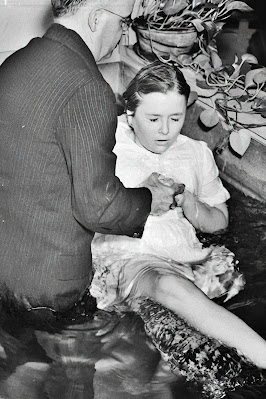 |
| Jesse Yelvington baptizing one of 51 new believers following a 1937 revival meeting at Baptist Temple. |
The first and longest of these periods of time was the Revivalism Era. The group that became Baptist Temple began as a Bible study meeting in a home but exploded in growth with tent revivals led by San Antonio City Missionary and Evangelist Doc Pegues. One or two week tent revivals were a popular and effective way of communicating the gospel in America at the start of the 20th Century and the Baptist General Convention of Texas sent evangelists around the state to start new churches.
As Baptist Temple became an established church, it would host two-week revivals in the Spring and Fall, featuring evangelists who would preach lively sermons with emotional appeal. At the end people would be pressed for a public decision to follow Christ and be baptized. Many decisions were first time conversions and others were re-dedications. During the summer, Baptist Temple would often participate in city-wide crusades preached by an evangelist with national and, even, international fame. These included Gipsy Smith and Billy Graham. Many church members would not only enthusiastically support their own revivals but would, often, attend revivals in neighboring churches.
Four out of the first nine pastors of Baptist Temple were discovered while preaching a revival. Clive L. Skinner had recently preached a two-week revival at Baptist Temple that led to 41 baptism and his calling as their pastor. Pastors Albert Beddoe and Jesse Yelvington both left Baptist Temple to pursue full-time evangelism.
Revivals required a lot of work and preparation. Deacons were charged with selecting the evangelist and arranging for his room and board. They would vote on a long list of potential preachers. Before the revival, lists of prospects would be put together and visits were made. Advertising and posters played a big role but word of mouth and personal invitations were the keys to filling the auditorium. An offering would be taken each night and given to the preacher and his team.
Follow up was equally vital to the long-term impact of the revival. The deacons divided San Antonio onto four areas. Deacons living in those areas would visit those who had made decisions to enroll them in Sunday School and schedule their baptism.
Sunday school was the foundation for both the start and the phenomenal growth of Baptist Temple and Baptist churches in general. It was the primary disciple-making ministry of the church. It is where new believers were strengthened in their faith and future leaders were discovered.
Pastor Vernon Elmore marked the end of the Revival Era. He was a popular and effective evangelist to whom the church had granted four weeks off to preach revivals in other places. This was on top of vacation and convention time. By the end of his tenure revivals had gone from two weeks to one week, to a few days; from twice a year to once, to sporadic scheduling. Revivals would be replaced by event evangelism. Block parties (like Baptist Temple's Fall Festival) would become the new normal. Guest evangelists would be replaced by Christian musical groups and Sunday morning celebrity testimonies.
Block parties, Christian concerts, and Vacation Bible School are what remain of the 57 year Revivalism Era at Baptist Temple (1906-1963).
No comments:
Post a Comment